Abstract
In June 2024, the Fermi Gamma-Ray Space Telescope (FGST) celebrated its 16th year of operations. The Fermi Large Area Telescope (Fermi-LAT) is the main instrument onboard the FGST satellite and is designed to be sensitive to -rays in the energy range from about up to the regime. From its launch, the Fermi-LAT has collected more than photon events, providing crucial information to improve our understanding of particle acceleration and -ray production phenomena in astrophysical sources. The most abundant in the last 4FGL-data release 4 (4FGL-DR4), most powerful and persistent -ray emitters in the sky are the Active Galactic Nuclei (AGNs). These sources are extremely luminous galaxy cores powered by a super massive black hole (SMBH) with a mass ranging from millions to billions of times the mass of the Sun. The ASI-SSDC, a facility of the Agenzia Spaziale Italiana (ASI), plays a pivotal role in supporting Fermi-LAT by providing the essential infrastructure for the storage, processing, and analysis of the vast amounts of data generated by the mission. As a key asset to various space missions, ASI-SSDC contributes significantly to advancing research in high-energy astrophysics and -ray observations.
1. Introduction
Active Galactic Nuclei (AGNs) are the extremely luminous central regions of galaxies, emitting energy across the electromagnetic spectrum, from radio waves to -rays. The extraordinary luminosity is produced by the accretion of matter onto SMBHs at the centers of their host galaxies. Their radiance is often higher than the combined light of all the stars within their galaxy and their variability shows changes in intensity over timescales ranging from minutes to years [1]. The diverse classifications of AGNs, such as quasi-stellar radio sources (quasars), radio galaxies, Seyfert galaxies, and blazars, underscore the rich observational complexity they offer. Despite their differences, they share a unifying characteristic as all of them host an SMBH actively accreting matter [2,3]. Each category provides unique perspectives on the interplay between black holes and their environments. Their emissions reveal the behavior of matter under extreme gravitational and magnetic fields, offering a unique window into the mechanics of accretion disks and the physics of relativistic jets. Furthermore, these energetic regions play a key role in understanding the history of galaxy formation and evolution. Indeed, their activity can significantly influence the interstellar environment of their host galaxies through feedback mechanisms that regulate star formation and affect the growth of the black hole itself. Research into these extraordinary objects continues to drive advancements in our understanding of the universe’s most energetic phenomena and the fundamental laws of physics that govern them.
The Fermi-LAT experiment [4], on board the Fermi Gamma-Ray Space Telescope (FGST) [5], plays a crucial role, allowing detailed observations of numerous AGNs and significantly contributing to understanding the mechanisms of -ray emission.
Other abundant extragalactic objects seen by Fermi-LAT and Fermi Gamma-ray Burst Monitor (Fermi-GBM) (the other instrument onboard the FGST) [6] instruments include Gamma-Ray Bursts (GRBs). They are essentially sudden emissions of rays ranging from a fraction of a second to several hours [7]. Sometimes, this manifests as a single event, often referred to as a fast rise exponential decay (FRED). In other instances, the bursts may exhibit multiple rises and falls throughout the prompt emission phase. Variability can be extremely rapid, with fluctuations observed on timescales as brief as milliseconds. Consequently, there are limits on the size of the region producing the GRB, as signals cannot traverse the region in less than the light travel time. During the bursting phase, the apparent luminosity of the bursts can exceed up to several orders of magnitude than that of any other source in the -ray sky. In particular, GRBs release most of their energy in the -ray spectrum, emitting the majority of their power at photon energies ranging from tens to hundreds of [7]. Some bursts have even been detected at energies [8]. The actual flux of a burst can be analyzed by examining its energy spectrum, commonly referred to as the or spectrum (respectively, the flux as a function of the frequency and the energy. This analysis reveals that GRBs exhibit a distinct spectral peak energy, typically in the hundreds of range. After a GRB, the system that generates them must either be destroyed or enter a quiescent phase significantly longer than the duration of GRB detection missions, the former probably being the case.
Since the beginning of its data collection, the Fermi Large Area Telescope (Fermi-LAT) has improved our understanding of the -ray universe, providing deep insights into Cosmic Rays (CRs) acceleration and -ray emission from various astrophysical objects. To date, the instrument has detected over 7000 sources and observed numerous significant transient phenomena. This highlights Fermi-LAT’s pivotal role in advancing multi-messenger astrophysics. Gamma-rays in the - range are also believed to result from the interactions and decays of dark matter (DM) particles. Detecting such signals with Fermi-LAT would offer evidence of DM, potentially revealing key aspects of its properties. In this paper, we will review some recent most important discoveries made by the Fermi-LAT collaboration.
2. The Fermi Large Area Telescope (Fermi-LAT)
The Fermi Gamma-Ray Space Telescope (FGST) (Figure 1), commonly referred as Fermi, was launched on 11 June 2008, from Cape Canaveral Kennedy Space Center (NASA-KSC) in Florida. It began its scientific mission in August 2008 and remains operational after 16 years of continuous science operations and all-sky survey.

Figure 1.
Pictorial view of the Fermi Gamma-Ray Space Telescope (FGST) [9].
FGST orbits the Earth at a low altitude of , with an inclination of relative to the equator, completing an orbit every and typically operates in sky-survey mode, scanning the entire sky every three hours (two orbits), although it can also switch to pointing mode to observe transient events of interest [10,11].
The primary instrument aboard FGST is the Fermi-LAT (Figure 2), which detects -rays through the pair-production process. It can measure -ray energies ranging from up to the scale. The Fermi-LAT is composed of a array of identical towers. Each tower houses a tracker (TKR) and a caloremeter (CAL). The TKR module contains tungsten foils to facilitate -ray conversion into electron-positron pairs and is equipped with 18 layers of silicon strip detectors (SSDs) to trace charged particles and pinpoint the incoming -ray direction. The CAL is made up of 96 cesium iodide crystal bars arranged in eight layers and measures the energy of incoming particles. Furthermore, an anti-coincidence detector (ACD), covering the TKR, allows us to distinguish incoming -rays from background CRs events, including electrons, protons, and heavier nuclei. It is made up of panels of plastic scintillators that are read out using wave-shifting fibers and photo-multiplier tubes (PMTs). Lastly, an aluminum grid supports the detector modules as well as the data acquisition (DAQ) system and computers, which are positioned beneath the CAL modules [4,12,13].
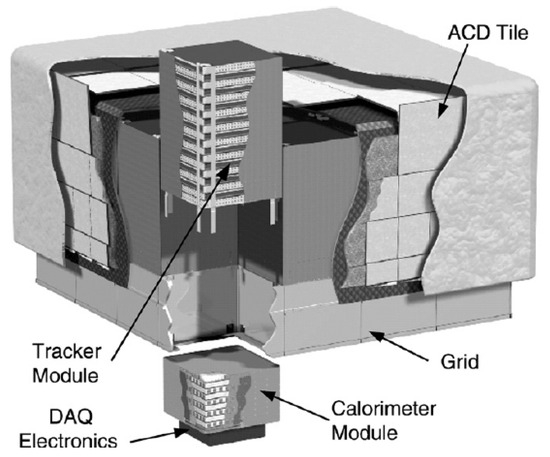
Figure 2.
The Fermi Large Area Telescope (Fermi-LAT) instrument subsystems [14].
3. Selected, Recent, Science Highlights from Fermi-LAT
3.1. Indirect DM Search with Fermi-LAT
The search for DM is one of the most fascinating and challenging fields in modern physics. Despite several pieces of evidence for its existence, such as gravitational effects on visible matter and cosmic structures, the fundamental nature of DM remains a profound mystery. Even if it is estimated that DM constitutes about 27% of the total energy density of the universe, we have not directly detected it [15]. One of the candidates for DM particles is the weakly interacting massive particle (WIMP). These particles are predicted to interact only via the weak force and gravity, making direct observation extremely difficult [16]. However, WIMPs may produce observable -ray spectral lines, such as those produced by the processes and , providing a clear and clean signal for DM detection [17].
Since the first years of Fermi-LAT observations, the collaboration performed several indirect searches for DM by looking for -rays that could be produced by WIMPs annihilation in the channel. For example, in the early 2010s, one of the key strategies focused on observing dwarf spheroidal galaxys (dSphs). Despite the extensive observation campaign, no significant -ray emission was detected from any of the dSphs that could be attributed to DM annihilation nor in the individual or in the combined analysis. The maximum test statistic (TS) value in the combined analysis was 1.3, observed for DM particles with a mass annihilating into , that is consistent with a background fluctuation. This null result, while disappointing in terms of direct detection, allowed the Fermi-LAT collaboration to set upper limits (ULs) at a confidence level (CL) of 95% CL on the WIMP annihilation cross-section across several annihilation channels, as , , and . In particular, limits are below the thermal relic cross-section for DM masses up to (Figure 3) [18].
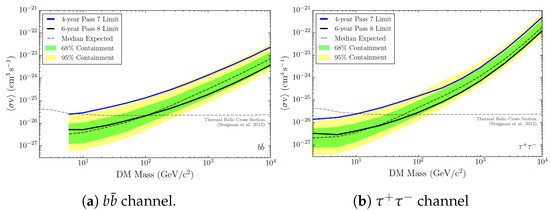
Figure 3.
Constraints on the DM annihilation cross-section at a 95% CL for the (a) and (b) channels. The dashed line represents the median expected sensitivity, while the surrounding bands illustrate the 68% and 95% quantiles. Each random set of locations has nominal J-factors that are randomized according to their measurement uncertainties. Additionally, the solid blue curve indicates the limits obtained from a previous study. The dashed gray line in this figure and in subsequent ones corresponds to the thermal relic cross-section [18].
More recently, analyzing 15 years of data from Fermi-LAT, new studies focused on constraining DM models where DM annihilates into monoenergetic photons, particularly through the Higgs portal mechanism. In this scenario, DM interacts with DM particles via the Higgs boson. Through both single and double line analyses of the Fermi-LAT data, the authors enhance constraints on DM annihilation rates, especially for large DM masses [17]. A central motivation for research in this area was to study how the Higgs portal DM annihilation could explain the galactic center excess (GCE) (GCE is an unexplained surplus of -rays observed from the Milky Way’s center). Some studies suggested that the GCE could result by the DM annihilation predominantly into pairs, a final state compatible with Higgs mediation. If DM annihilation occurs through the Higgs at resonance:
being the Higgs mass. This could explain the GCE. However, such a scenario would also predict -ray lines, which the authors attempt to detect in this analysis. The analysis focused on clean events that ensure the highest energy resolution. They studied -ray events in the energy range from to , dividing the data into three region of interests (ROIs) around the Galactic Center with radii of , and . Point sources in these regions were excluded based on the 4FGL catalog, and the galactic plane was masked to avoid contamination. The analysis consisted of single-line searches, which look for monoenergetic -rays from annihilation, and double-line searches, which account for both and interactions. Double-line searches are particularly effective at high DM masses because the branching ratio of the process increases with the energy. To fit the data, the authors used a maximum likelihood approach. The likelihood function was modeled using Poisson statistics, where the observed number of events is compared to the expected background and signal contributions. For each region of interest, it is given by:
where is the observed number of events in a given energy bin, and is the expected number of counts, including both background and potential signal contributions. The analysis found no statistically significant spectral lines in either the single or double line searches. The highest local significances observed were less than , far below the level required for a discovery. Despite that, the authors set new ULs on the annihilation cross-section , especially at high energies. These constraints are stronger than those of previous studies, especially for DM masses above , where the double-line analysis is more effective (Figure 4). Moreover, it could be possible to place significant constraints on Higgs-portal DM models. Specifically, a Higgs portal DM model that explains the GCE through annihilation at the resonance be fine-tuned to avoid producing detectable -ray lines. Lastly, the obtained constraints, combined with limits from direct detection experiments and collider searches for invisible Higgs decays, further restricted the allowed parameter space for Higgs-portal DM.
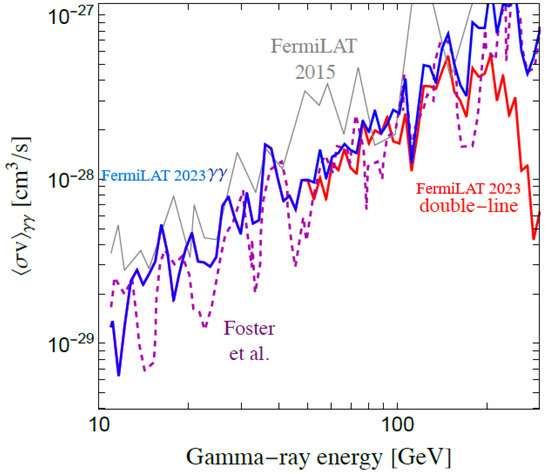
Figure 4.
Results from single-line analysis (blue) and the Higgs-portal double-line analysis (red), both based on an Navarro-Frenk-White (NFW) profile in one of the considered ROI region [17]. For comparison, the authors also included single-line results from previous Fermi-LAT results published in [19], displayed as a gray line, and more recent published in [20], represented by a dashed magenta line.
3.2. The Brightest of All Time (BOAT) GRB
On 9 October 2022, the astronomical community observed the detection of GRB221009A, a GRB with unprecedented luminosity and duration. GRB221009A quickly gained attention, triggering numerous instruments, including Fermi-LAT. This GRB has been recognized as the Brightest of All Time (BOAT) ever detected, marking it as a rare and remarkable event in the history of -ray astrophysics.
The first detection came from the Fermi-GBM at 13:16:59 coordinated universal time (UTC) (hereafter referred to as ), which triggered the event, designated as 221009553[21]. However, issues with the ground segment delayed the immediate distribution of alerts. Shortly after, the Swift Burst Alert Telescope (Swift-BAT) [22] reported an exceptionally bright transient source, initially misidentified as a Galactic object because of its proximity to the Galactic plane. Later, both the instruments confirmed the source as GRB221009A, a super-bright, long-duration GRB. The burst was characterized by two distinct emission phases. The first one was a brief initial episode of about followed by an extraordinarily intense and extended phase. Fermi-GBM data revealed that the peak flux and fluence (A measure of the total energy emitted) of GRB221009A were the highest ever recorded in the FGST mission’s history, surpassing all previous GRBs. Other instruments, like Konus/WIND [23], confirmed that GRB221009A was the brightest burst in their 28 years of operation.
Approximately 240 s after the Fermi-GBM trigger, the Fermi-LAT detected a photon with an energy of , setting a new record for the highest-energy photon observed during a GRB. This record was later broken again when an even more extraordinary photon with an energy of was detected by Fermi-LAT about nine hours after the burst’s onset [24,25]. Moreover, the Large High Altitude Air Shower Observatory (LHAASO) [26] reported photons with energies exceeding , with a maximum photon energy of , further underlining the extreme nature of this event [27,28,29]. Shortly after, the Carpet-2 experiment [30] at the Baksan Neutrino Observatory (BNO) detected an extensive air shower (EAS), likely initiated by a photon with an energy of , originating from the same GRB [31].
GRB221009A presented unique challenges for the Fermi-LAT. The intensity of the hard X-rays and soft -rays during the brightest phase of the burst overwhelmed the detector, leading to significant noise that affected data collection. Consequently, a specialized non-standard analysis has been developed, because the standard Fermi-LAT Instrument Response Functions (IRFs) could not reliably handle the data during these extreme conditions. This phase, known as the bad time interval (BTI), spanned from to , during which standard data analysis was not possible (Figure 5). On the contrary, the peak flux could actually be measured with the much less sensitive detector GRBAlpha on board a CubeSat satellite [32]. Outside this interval, Fermi-GBM and LAT low energy (LLE) (It is a mode of the Fermi-LAT designed to enhance the sensitivity of -ray detection in the energy range since up to , particularly useful for analyzing GRBs and other low-energy astrophysical events) data were used to perform a joint analysis.
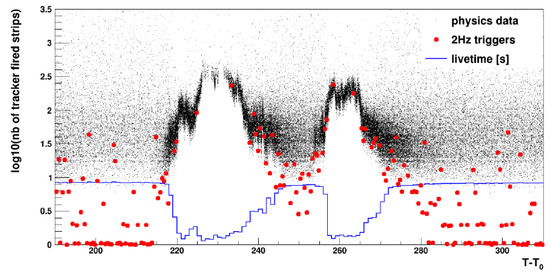
Figure 5.
The number of tracker strips activated during events that include at least one track passing through the -ray main trigger and on-board filter is plotted over time since the Fermi-GBM trigger, represented by black dots. The red dots indicate events triggered at a cadence of , which were used to monitor instrument noise. Meanwhile, the blue histogram illustrates the livetime captured in the one-second spacecraft file. Under typical data collection conditions—prior to and following , the tracker noise can occasionally register as empty. However, during the peak brightness of the GRB’s prompt emission, it consistently remains populated, often exceeding 100 activated strips. It is important to note that the extremely high flux during the burst results in significant deadtime, which prevents the maintenance of the 2 Hz periodic triggering cadence [24].
The spectral analysis of GRB221009A revealed interesting results. During the prompt emission phase, Fermi-LAT detected a very high -ray flux, with photons above rapidly increasing just before the BTI. A key finding from this analysis is that the high-energy events observed by Fermi-LAT during the prompt phase did not have a synchrotron origin. Instead, they were more consistent with an additional synchrotron self-compton (SSC) component, where synchrotron photons are upscattered to higher energies by the same population of electrons. This mechanism helped to explain the extreme energies observed during the burst.
The afterglow phase, which decays as a power law, exhibited high-energy extended emission similar to other Fermi-LAT detected GRBs. Interestingly, Fermi-LAT data suggested that the afterglow emission might have started during the prompt phase, as indicated by observations from LHAASO. The detection of a photon during the late-time emission highlighted the unique energy scale associated with this event (Figure 6).
GRB221009A has also relevance for DM detection. As already discussed, LHAASO observeded very high energy (VHE) photons up to and Carpet-2 up to . However, given the redshift of GRB221009A (), the flux of photons with energies greater than should be heavily attenuated by the extragalactic background light (EBL) through electron-positron pair production. For example, the attenuation for a photon of at this redshift would be between and , making such detections difficult to explain under conventional physics. The LHAASO collaboration has recently proposed that photons-Axion-Like Particle (ALP) oscillations could provide a solution to this problem by reducing the effective optical depth of multi- photons. By considering ALPs with mass and two-photon coupling the authors of this study showed that photon survival of multi- photons significantly increase, then this could explain LHAASO detection above . In addition, their results are in agreement with previous hints at ALP existence, making ALPs a good candidate for cold DM. The authors also investigated the lorentz invariance violation (LIV) scenario. In this case, the results cannot explain the photon detection by LHAASO but can explain the Carpet-2 photon detection. New results from spectral data by such as Astrofisica con Specchi a Tecnologia Replicante Italiana (ASTRI) [33] and Čerenkov Telescope Array (CTA) [34], possible polarization data from such as Imaging X-ray Polarimetry Explorer (IXPE) [35], Next Generation X-ray Polarimeter (NGXP) [36], Compton Spectrometer and Imager (COSI) [37] and All-sky Medium Energy Gamma-ray Observatory (AMEGO) [38] and from laboratory experiments such as Any Light Particle Search II (ALPSII) [39] and International Axion Observatory (IAXO) [40] are needed to confirm or disprove ALPs. This study has been carried out by another collaboration (the LHAASO one), for more details about it, please refer to [31,41]).
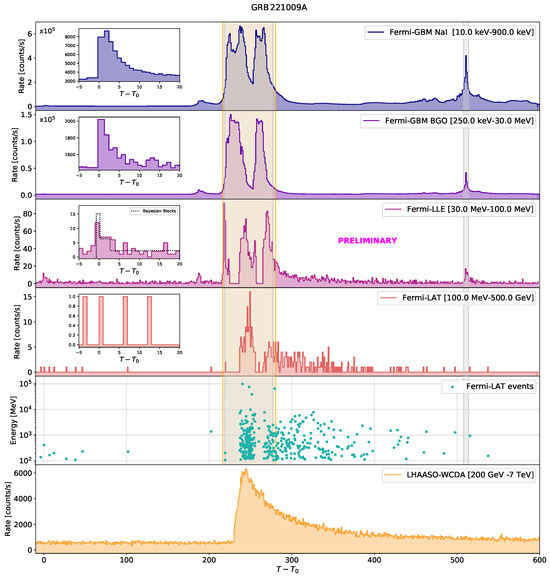
Figure 6.
The multi-wavelength light curves for the first following the Fermi-GBM trigger of GRB221009A illustrate the primary emissions across a wide gamma-ray spectrum. The initial two panels present data from the Fermi-GBM NaI and BGO detectors, while the third panel displays LLE data. The fourth panel depicts the Fermi-LAT light curve, and the fifth shows individual Fermi-LAT photons along with their corresponding energies. Finally, the last panel features the LHAASO light curve. Shaded regions indicate the BTIs: the orange area marks the period during which Fermi-LAT data cannot be analyzed using standard procedures, whereas the gray area corresponds to the Fermi-GBM BTI. The inset panel in the first four panels provides a closer view of the triggering pulse within the first . Additionally, the LLE light curve is presented, with a black dashed line representing the data binned using the Bayesian blocks algorithm [42].
3.3. Periodic Modulation of the -Ray Flux of PG 1553+113
PG 1553+113 is a prominent -ray blazar that exhibited periodic variations in its -ray flux, with an oscillation period of approximately 2.1 years. This periodicity was initially detected using the Fermi-LAT data based on a 7-year data collection [43]. To further investigate this signal, a more extensive dataset, covering 15 years of continuous Fermi-LAT observations, was analyzed, effectively doubling the time period under consideration. This extended dataset provided stronger statistical evidence for the periodic modulation, with the oscillation reaching a significance of when compared to simulations of stochastic red noise, substantially improving upon the initial detection. The periodicity was confirmed by independent analyses of the earlier and new data segments, with both sections showing consistent periods and phases, yielding a chance probability of less than that the oscillations would align so closely by random chance. This established the periodicity as a robust and coherent feature over the entire 15-year observational (Figure 7) span [1].
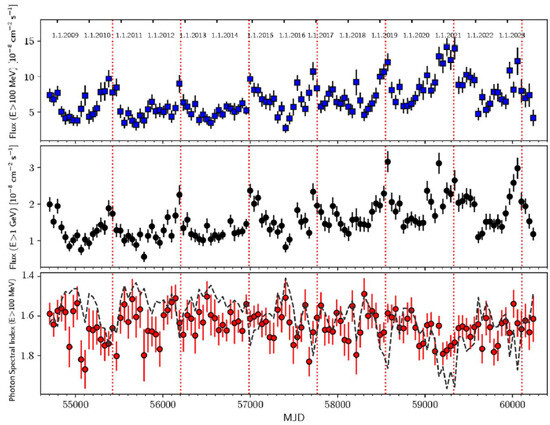
Figure 7.
Gamma-ray flux light curves and spectral index evolution of PG 1553+113 observed by Fermi-LAT over a span of more than 15 years, from August 2008 to November 2023. The top and middle panels display light curves for energies above and , respectively, using a 45-day binning interval. The bottom panel shows the time evolution of the spectral index , with the -ray light curve for overlaid as a dashed line for comparison [1].
The authors also performed a detailed multiwavelength analysis, incorporating data from several key instruments. X-ray data from the Swift X-ray telescope (XRT) [44] and the Burst Alert Telescope (BAT) [45], as well as ultra violet (UV) and optical observations from the ultraviolet and optical telescope (UVOT) [46], and ground-based observatories including Katzman Automatic Imaging Telescope (KAIT) [47], the Catalina Sky Survey [48], and the Owens Valley Radio Observatory [49], were all analyzed in conjunction with the Fermi-LAT data. The results revealed clear correlations between the -ray flux and both the optical and radio light curves. Specifically, the optical flux showed a time lag of approximately relative to the -ray oscillations, while the radio flux at , from Owens valley radio observatory (OVRO) [49], exhibited a longer lag of . On the contrary, no significant correlation was found with the X-ray flux, indicating a stronger coupling between the -ray emission and the lower-energy bands of the electromagnetic spectrum, especially in the optical and radio wavelengths (Figure 8).
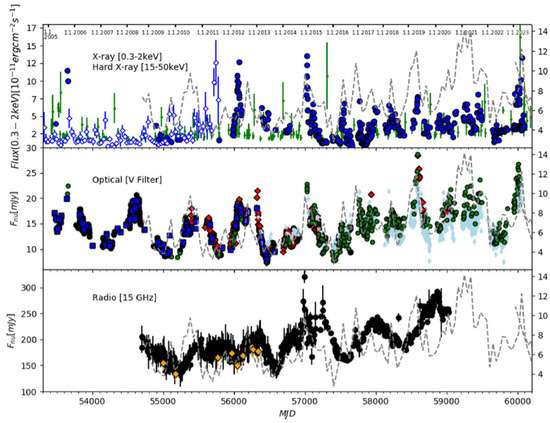
Figure 8.
Multiwavelength light curves of PG 1553+113 across X-ray, soft -ray, optical, and radio bands, with the Fermi-LAT -ray light curve for overlaid as a dashed gray line. Top panel: Swift XRTintegrated flux in the – range is represented by blue-filled circles. Swift BAT count rates in the – band, scaled to match the X-ray flux for comparison, are plotted in green. Central panel: Optical flux density data include contributions KAIT (V-filter rescaled, red diamonds) and Swift UVOT. Bottom panel: Radio flux density at from the OVRO telescope is shown as black-filled circles, with parsec-scale [1].
In addition to the light curve analysis, pulse timing studies were conducted over eight full cycles of the observed -ray oscillation. These timing analyses demonstrated that the arrival times of the pulses are consistent with a strictly coherent periodicity. This confirmed the presence of a stable, long-term oscillation. The -ray spectrum showed an energy-dependent behavior of the periodic oscillation, with the amplitude of the modulation being more pronounced at energies above 1 GeV compared to lower energies. Moreover, a softening feature was observed in the rising phase of the oscillation, possibly linked to a precursor event.
The most plausible astrophysical model to explain the observed -ray periodicity involved a binary SMBH system, where pulsations in the accretion flow around the primary SMBH could modulate the energy and material supply to the relativistic jet. The binary system, with a mass ratio that suggests an elevated mass of the secondary black hole, could induce orbital modulations that lead to periodic variations in the jet’s emission. The authors also explored other potential models, including disk and jet precession, jet instabilities, and the effects of gravitational perturbations from nearby massive stars or intermediate-mass black holes (IMBHs). However, the 2.1-year periodicity did not appear to be consistent with the precession timescales of the black holes. That is because the corresponding orbital merging timescales would be too short (less than 1 year) for such precession to account for the observed variability.
Furthermore, the periodic modulation observed in PG 1553+113 might be associated with a hydrodynamic variability in the fueling of the primary SMBH, where the periodicity could arise from the interaction between the accretion flow and the jet’s magnetic field. As the material from the accretion disk moves into the jet, magnetorotational stresses could energize electron populations, producing periodic modulations in the -ray flux. The relatively long timescale of the periodicity (∼2.1 years) suggested that this process might survive for the duration of the gravitational wave merger timescale for the binary system, estimated to be on the order of to years, depending on the mass ratio of the black holes.
Moreover, the authors discussed the potential connection between PG 1553+113 and the stochastic gravitational wave background, highlighting that binary SMBHs in blazars could contribute to this background, detectable by pulsar timing arrays (PTAs). PG 1553+113, with its well-defined quasi-periodic oscillation (QPO) and its binary SMBH system, could be one of the strongest candidates for contributing to the low-frequency gravitational wave background.
Additionally, according to the authors, future observations in higher-energy bands, particularly in X-rays and VHE rays, as well as regular radio and optical polarization monitoring, will be crucial to further investigate the nature of this periodic variability and its broader implications for astrophysical models of SMBH binaries and multimessenger astronomy. Observations of the jet’s structure, such as helical or wiggling patterns, as well as polarization studies and spectroscopic analysis, may offer further insights into the underlying mechanisms driving the periodic variability. The results also pave the way for the future detection of gravitational waves from these systems, which may be achievable with facilities such as the Square Kilometre Array (SKA) [50].
4. Fermi-LAT Catalogs
The Fermi-LAT collaboration has released subsequent -ray source catalogs, cumulating and integrating the all-sky survey data, each time using more extensive data and improving analytical techniques. These include both general and class-specific catalogs. One of them, known as the Fermi large area telescope fourth catalog (4FGL) lists all observed -ray sources by Fermi-LAT and it is based on data from the first eight years of Fermi-LAT operations, covering an energy range from to (Figure 9). This catalog has been updated three times to include new data and an improved data analysis.
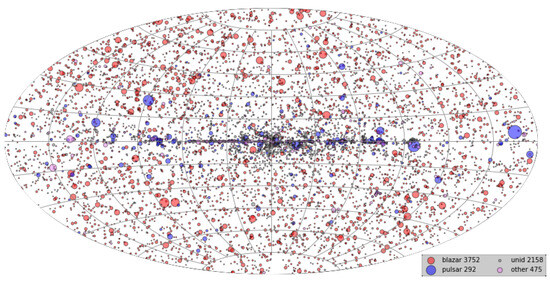
Figure 9.
Sky map, in Galactic coordinates, showing the sources contained in the 4FGL-data release 3 (4FGL-DR3) catalog [51].
The latest version is the 4FGL-DR4 [52], that includes more than 7000 -ray sources, most of which are AGNs. It contains 26 new associations regarding former sources and 236 regarding new ones. In addition, several changes have been performed too. A total of approximately 550 new sources have been added. The data for the 4FGL-DR4 catalog were collected between 4 August 2008 and 2 August 2022, spanning a total of 14 years. During most of this period, FGST operated in a sky-scanning survey mode, alternating the viewing direction north and south of the zenith on different orbits and allowing the observation of the entire sky approximately every three hours.
In the analysis for the 4FGL-DR4 catalog, the same models for interstellar emission and isotropic spectrum were used as in previous data release 3 (DR3), but improvements were made to enhance the process. The normalization of the isotropic component was fixed to 1, allowing modulation of the Galactic component using a log-parabola (LP) function for each ROI. A smoothing method was applied to derive a global mapping of parameters across the sky, taking into account the distance to adjacent ROIs and statistical weights.
The original Galactic model was adjusted using these parameters, with maximum likelihood fitting fixing the isotropic component. Comparing 4FGL-DR4 and 4FGL-DR3 results, it is possible to notice narrower parameter distributions and improvements in source significance, with an increase of 71 sources above the detection threshold. However, the method mainly affected the Galactic diffuse component, resulting in a slight increase in energy flux and a decrease in the number of curved spectra.
To avoid the changes of the diffuse parameters at ROI boundaries an interpolation over diffuse parameters to make them vary smoothly over the sky has been performed weighting up to 15 ROIs as:
where and are, respectively, the distance to ROI center, the ROI radius and the uncertainty.
The isotropic component, which accounts for the uniform background radiation, was fixed to maintain focus on localized emissions from the Milky Way. Additionally, the LP modulation was applied to smooth out rapid fluctuations in the Galactic diffuse emission. This approach aimed to reduce noise and enhance the accuracy of the -ray models, allowing for clearer insights into astrophysical processes.
The issue of variable -ray sources, which can dilute transient signals over long periods, was addressed by including the brightest transients that reach a TS significance level over one year.
5. The ASI—Space Science Data Center (ASI-SSDC)
The ASI—Space Science Data Center (ASI-SSDC) [53] is a multi-mission facility of the ASI, established in September 2000 at the ESA—European Space Research Institute (ESA-ESRIN) facility. Initially created as a permanent archive for BeppoSAX X-ray data [54], it expanded its scope to support several space missions. The center is dedicated to managing and organizing information technology (IT) tasks related to the observation of the universe and plays a crucial role in transforming space observations into scientific knowledge. The facility operates through a collaborative effort involving the ASI, Istituto Nazionale di Astrofisica (INAF), and INFN for scientific data processing and analysis, as well as industrial partners like Telespazio and SERCO for IT support. Together, they design, implement, and manage hardware and software systems for acquiring, storing, processing, and distributing scientific data. The center’s activities include archiving, multi-frequency studies, source cataloging, quick-look science analysis, and interactive data visualization and exploration. Following the principles of accessibility, interoperability, and reusability, the ASI-SSDC ensures the long-term preservation of archives, supports cross-mission and multi-frequency analyses, and promotes the exchange of public data, and software. Moreover, several studies about data mining, machine learning, and artificial intelligence (AI) are in progress for future advancements in space science research.
The multi-mission interactive archive (MMIA) [55] is a web-based service that allows access to data from multiple space missions, offering interactive tools to generate high-level products ready for scientific use. Users can explore comprehensive multi-frequency information through specialized utilities such as the spectral energy distribution (SED) builder [56]. The MMIA webpage allows queries of the ASI-SSDC online archives by source name, coordinates with cone radius, time intervals, and source class or type, eliminating the need to manage mission-specific details. It also provides features for web-based quick-look data processing, data distribution, and the publication of source catalogs with interactive tables. An important interactive scientific tool available at the ASI-SSDC is the Sky Data Explorer [57] (Figure 10). This tool is designed to visualize and analyze the data stored in the MMIA. It presents quick-look visualizations of sky regions across various electromagnetic energy bands, facilitates cross-correlation with astronomical source catalogs, and offers direct links to external services.
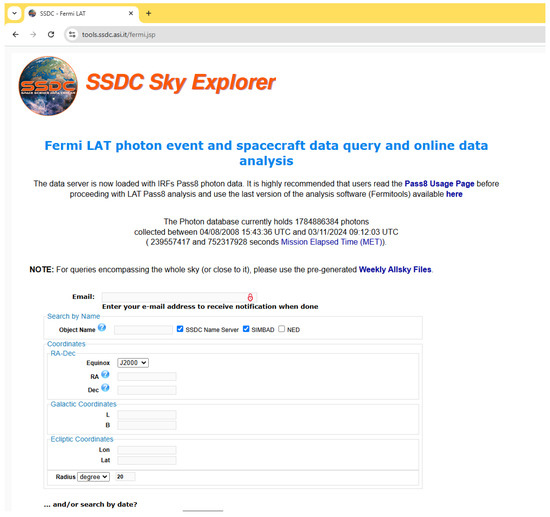
Figure 10.
The web page of the sky explorer tool dedicated to the Fermi-LAT experiment, hosted on the ASI-SSDC site. The tool is available on https://tools.ssdc.asi.it/ (accessed on 8 February 2025).
One of the key results of the scientific work at ASI-SSDC is the publication of source catalogs, which are generated from mission data. They are public and free to be used by the scientific community and serve as the basis for further analysis through the data explorer tool. The catalogs are organized into various categories based on the energy band they correspond to, such as -rays or X-rays, and can be accessed from the ASI-SSDC website’s homepage https://www.ssdc.asi.it/ [58].
Fermi-LAT at ASI-SSDC
The ASI-SSDC plays a pivotal role in supporting Fermi-LAT, providing critical infrastructure for the storage, processing, and analysis of the huge quantity of data. In particular, the center plays a key role in supporting Fermi-LAT science data exploitation by providing infrastructure for acquiring information from the Instrument Science Operation Center (ISOC) (Hosted at Stanford) and managing the processing, distribution, and initial quick-look analysis of -ray photon observations. These fully public datasets are made accessible through the ASI-SSDC, enabling researchers worldwide to explore Fermi-LAT observations and contribute to a wide range of astrophysical research.
Beyond data archiving and management, the local team collaborates on data processing and calibration studies, supporting the development of tools like the Fermi-LAT online data analysis (FODA). This platform allows users to explore -ray count maps, pre-processed light curves, catalog source spectra, and perform initial, quick-look, interactive -ray point source analysis. In this context, the Fermi-LAT team at ASI-SSDC also curates interactive tables of published source catalogs. These catalogs, produced through extensive data analysis, are made publicly available alongside the -ray data, serving as a valuable resource for detailed studies of gamma-ray sources. An example of a published catalog is the 4FGL-DR3 (Figure 11), while the team is currently working to publish the 4FGL-DR4.
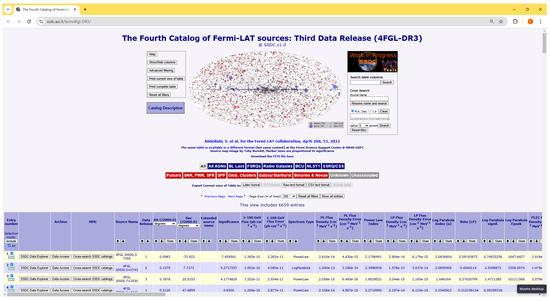
Figure 11.
Web page of 4FGL-DR3 interactive catalog on ASI-SSDC site. The catalog is available on https://www.ssdc.asi.it/fermi4fgl-DR3/ (accessed on 8 February 2025).
In addition, the Fermi-LAT team at ASI-SSDC also promotes collaboration with national and international scientific teams that study photon data with data and observations obtained with other space satellites and ground-based observatories across the electromagnetic spectrum. For instance, on 23 June 2024, the ASI-SSDC team involved in the Fermi-LAT project observed enhanced -ray activity from the peculiar -ray radiogalaxy SBS 1343+537. A preliminary analysis conducted by the Fermi-LAT flare advocate (The Fermi-LAT flare advocate is a rotating role among collaboration members, with each member taking a one-week shift to monitor and analyze high-energy transient events, such as flares detected by Fermi-LAT. The advocate identifies significant activity, issues alert to the scientific community, and facilitates follow-up observations) revealed that the source was in a state of elevated -ray emission. On that day, the average daily emission was measured as (statistical uncertainty only) [59]. This represents an increase of approximately 30 times compared to the flux reported in the 4FGL-DR4 catalog, . The corresponding photon spectral index during the flare was , which is harder than the catalog value, . Following the flaring activity detected by Fermi-LAT, several target of opportunitys (ToOs) were triggered for Neil Gehrels Swift observatory (NGSO) observations [60], leading to multiple observations [61], as well as for the Sardinia Radio Telescope (SRT) [62] in the radio band. Data analysis from these follow-up campaigns is currently in progress.
Lastly, ASI-SSDC also plays a useful role in making Fermi-LAT’s discoveries accessible beyond the scientific community, through public outreach initiatives, such as for example, during the Fermi Masterclass dedicated to high school students.
6. Conclusions
Fermi-LAT has improved our understanding of high-energy astrophysical phenomena during its 16 years of continuous operation. By detecting over 7000 -ray sources, Fermi-LAT has shed light on a diverse range of cosmic events, from powerful AGNs to transient phenomena such as GRBs. The detailed data collected by Fermi-LAT have been crucial to unraveling the mechanisms of particle acceleration and -ray production, improving our knowledge of extreme phenomena in the universe.
The insights gained from Fermi-LAT’s observations have not only advanced the field of astrophysics but have also opened new avenues for multi-messenger astronomy, where observations across different wavelengths provide a global view of cosmic events. The mission’s ability to observe AGNs, characterized by their immense luminosity and variability, has led to significant discoveries regarding the physics of SMBH and the dynamics of accretion processes.
Moreover, Fermi-LAT’s results regarding the DM have set stringent limits on it. Although the experiment did not provide evidence for DM, the obtained results contribute to refining theoretical models and guide future researches.
One of the most recent and remarkable highlights of the mission has been the detection of GRB221009A, which has been designated the brightest -ray burst ever observed. This extraordinary event shows the capabilities of Fermi-LAT to capture high-energy emissions and demonstrates the importance of prompt and coordinated responses from the scientific community. The analysis of GRB221009A, including its high-energy photons and extended emission, underscores the significance of Fermi-LAT in unraveling the complexities of such energetic phenomena.
As the Fermi-LAT mission continues its observations, the wealth of data it produces will remain a critical resource for ongoing and future research in high-energy astrophysics. The collaboration among scientists, facilitated by institutions such as the ASI-SSDC, will ensure that these insights are thoroughly explored and disseminated. This will expand our understanding of the universe’s most extreme processes and inspire future generations of researchers to explore the mysteries of the cosmos.
Author Contributions
F.C.: Conceptualization, data collection, and writing—original draft preparation. F.C. is member of ASI-SSDC working in the Fermi-LAT experiment—he conducted an extensive review of the existing literature, organized the findings, and wrote the manuscript. S.C.: Review and funding acquisition. Stefano Ciprini is member of ASI-SSDC working in the Fermi-LAT experiment. He carefully reviewed the manuscript, providing constructive feedback. He also promoted the research grant that supported the work of the first author. D.G.: Review. Dario Gasparrini is member of ASI-SSDC working in the Fermi-LAT experiment. He carefully reviewed the manuscript, providing constructive feedback, to improve the manuscript’s clarity and quality. F.G.: Member of the ASI-SSDC. All authors have read and agreed to the published version of the manuscript.
Funding
This work was supported by the grant “SSDC_043—CUP F85F21006430005”, which funded the research fellowship of the first author.
Data Availability Statement
No new data were generated or analyzed in this study. This is a review manuscript based on previously published works. Plots presented in this manuscript have been reproduced from previously published works. The original sources have been explicitly cited in the respective figure captions. We extend our gratitude to the authors and publishers of the original works.
Acknowledgments
Fausto Casaburo would also like to thank the funding from the INFN Roma Tor Vergata and Commissione Scientifica Nazionale 2 (CSN2), for their support, which made it possible for the author to attend the XIII International Conference on New Frontiers in Physics (ICNFP) where part of this review was presented.
Conflicts of Interest
The authors declare that they have no conflicts of interest.
Abbreviations
| 4FGL | Fermi large area telescope fourth catalog |
| 4FGL-DR3 | 4FGL-data release 3 |
| 4FGL-DR4 | 4FGL-data release 4 |
| ACD | anti-coincidence detector |
| AGN | Active Galactic Nucleus |
| AI | artificial intelligence |
| ALP | Axion-Like Particle |
| ALPSII | Any Light Particle Search II |
| AMEGO | All-sky Medium Energy Gamma-ray Observatory |
| ASI | Agenzia Spaziale Italiana |
| ASI-SSDC | ASI—Space Science Data Center |
| ASTRI | Astrofisica con Specchi a Tecnologia Replicante Italiana |
| BAT | Burst Alert Telescope |
| BOAT | Brightest of All Time |
| BNO | Baksan Neutrino Observatory |
| BTI | bad time interval |
| CAL | caloremeter |
| CSN2 | Commissione Scientifica Nazionale 2 |
| CTA | Čerenkov Telescope Array |
| CL | confidence level |
| COSI | Compton Spectrometer and Imager |
| CR | Cosmic Ray |
| DAQ | data acquisition |
| DM | dark matter |
| DR3 | data release 3 |
| dSph | dwarf spheroidal galaxy |
| EAS | extensive air shower |
| EBL | extragalactic background light |
| ESA-ESRIN | ESA—European Space Research Institute |
| Fermi-GBM | Fermi Gamma-ray Burst Monitor |
| Fermi-LAT | Fermi Large Area Telescope |
| FGST | Fermi Gamma-Ray Space Telescope |
| FODA | Fermi-LAT online data analysis |
| FRED | fast rise exponential decay |
| GCE | galactic center excess |
| GRB | Gamma-Ray Burst |
| IAXO | International Axion Observatory |
| ICNFP | International Conference on New Frontiers in Physics |
| IMBH | intermediate-mass black holes |
| IT | information technology |
| INAF | Istituto Nazionale di Astrofisica |
| INFN | Istituto Nazionale di Fisica Nucleare |
| IRF | Instrument Response Functions |
| ISOC | Instrument Science Operation Center |
| IT | information technology |
| IXPE | Imaging X-ray Polarimetry Explorer |
| KAIT | Katzman Automatic Imaging Telescope |
| LIV | lorentz invariance violation |
| LLE | LAT low energy |
| LHAASO | Large High Altitude Air Shower Observatory |
| LP | log-parabola |
| MMIA | multi-mission interactive archive |
| NASA-KSC | Cape Canaveral Kennedy Space Center |
| NFW | Navarro-Frenk-White |
| NGSO | Neil Gehrels Swift observatory |
| NGXP | Next Generation X-ray Polarimeter |
| OVRO | Owens valley radio observatory |
| PMT | photo-multiplier tube |
| PTA | pulsar timing array |
| quasar | quasi-stellar radio source |
| QPO | quasi-periodic oscillation |
| ROI | region of interest |
| SMBH | super massive black hole |
| SSC | synchrotron self-compton |
| SED | spectral energy distribution |
| SKA | Square Kilometre Array |
| SSD | silicon strip detector |
| SRT | Sardinia Radio Telescope |
| Swift-BAT | Swift Burst Alert Telescope |
| ToO | target of opportunity |
| TKR | tracker |
| TS | test statistic |
| UL | upper limit |
| UTC | coordinated universal time |
| UV | ultra violet |
| UVOT | ultraviolet and optical telescope |
| VHE | very high energy |
| WIMP | weakly interacting massive particle |
| XRT | X-ray telescope |
References
- Abdollahi, S.; Baldini, L.; Barbiellini, G.; Bellazzini, R.; Berenji, B.; Bissaldi, E.; Blandford, R.D.; Bonino, R.; Bruel, P.; Buson, S.; et al. Periodic Gamma-Ray Modulation of the Blazar PG 1553+113 Confirmed by Fermi-LAT and Multiwavelength Observations. Astrophys. J. 2024, 976, 203. [Google Scholar] [CrossRef]
- Peterson, B.M. An Introduction to Active Galactic Nuclei; Cambridge University Press: Cambridge, UK, 1997. [Google Scholar]
- Krolik, J.H. Active Galactic Nuclei: From the Central Black Hole to the Galactic Environment; Princeton University Press: Princeton, NJ, USA, 1999; Volume 60. [Google Scholar]
- Atwood, W.B.; Abdo, A.A.; Ackermann, M.; Althouse, W.; Anderson, B.; Axelsson, M.; Baldini, L.; Ballet, J.; Band, D.L.; Barbiellini, G.; et al. The Large Area Telescope on the Fermi Gamma-Ray Space Telescope Mission. Astrophys. J. 2009, 697, 1071–1102. [Google Scholar] [CrossRef]
- Thompson, D.J.; Wilson-Hodge, C.A. Fermi Gamma-Ray Space Telescope. In Handbook of X-Ray and Gamma-Ray Astrophysics; Springer: Singapore, 2022; pp. 1–31. [Google Scholar] [CrossRef]
- Meegan, C.; Lichti, G.; Bhat, P.N.; Bissaldi, E.; Briggs, M.S.; Connaughton, V.; Diehl, R.; Fishman, G.; Greiner, J.; Hoover, A.S.; et al. The Fermi Gamma-ray Burst Monitor. Astrophys. J. 2009, 702, 791–804. [Google Scholar] [CrossRef]
- Levan, A. Gamma-Ray Bursts; 2514-3433; IOP Publishing: Bristol, UK, 2018. [Google Scholar] [CrossRef]
- Abdo, A.A.; Ackermann, M.; Arimoto, M.; Asano, K.; Atwood, W.B.; Axelsson, M.; Baldini, L.; Ballet, J.; Band, D.L.; Barbiellini, G.; et al. Fermi Observations of High-Energy Gamma-Ray Emission from GRB 080916C. Science 2009, 323, 1688–1693. [Google Scholar] [CrossRef] [PubMed]
- NASA LAT Collaboration. Fermi-LAT Pictorial View. Available online: https://fermi.gsfc.nasa.gov/science/constellations/pages/inc/img/fermi/Fermi_Artwork.jpg (accessed on 8 February 2025).
- Fermi Collaboration. Fermi Gamma-Ray Space Telescope. 2008. Available online: https://fermi.gsfc.nasa.gov/ (accessed on 8 February 2025).
- Strigari, L.E. Galactic searches for dark matter. Phys. Rep. 2013, 531, 1–88. [Google Scholar] [CrossRef]
- Ajello, M.; Atwood, W.B.; Axelsson, M.; Bagagli, R.; Bagni, M.; Baldini, L.; Bastieri, D.; Bellardi, F.; Bellazzini, R.; Bissaldi, E.; et al. Fermi Large Area Telescope Performance after 10 Years of Operation. Astrophys. J. Suppl. Ser. 2021, 256, 12. [Google Scholar] [CrossRef]
- GLAST Facility Science Team; Gehrels, N.; Michelson, P. GLAST: The next-generation high energy gamma-ray astronomy mission. Astropart. Phys. 1999, 11, 277–282. [Google Scholar] [CrossRef]
- ASI-SSDC. Fermi-LAT Pictorial View. Available online: https://fermi.ssdc.asi.it/images/imgfermiasdc4.png (accessed on 8 February 2025).
- Netchitailo, V. Dark Matter Particles. J. High Energy Phys. Gravit. Cosmol. 2023, 09, 1004–1020. [Google Scholar] [CrossRef]
- Queiroz, F. WIMP Theory Review. arXiv 2017, arXiv:1711.02463. [Google Scholar] [CrossRef]
- Luque, P.D.L.T.; Smirnov, J.; Linden, T. Gamma-Ray Lines in 15 Years of Fermi-LAT Data: New Constraints on Higgs Portal Dark Matter. arXiv 2023, arXiv:2309.03281. [Google Scholar]
- Ackermann, M.; Albert, A.; Anderson, B.; Atwood, W.; Baldini, L.; Barbiellini, G.; Bastieri, D.; Bechtol, K.; Bellazzini, R.; Bissaldi, E.; et al. Searching for Dark Matter Annihilation from Milky Way Dwarf Spheroidal Galaxies with Six Years of Fermi-LAT Data. Phys. Rev. Lett. 2015, 115, 231301. [Google Scholar] [CrossRef]
- Ackermann, M.; Ajello, M.; Albert, A.; Anderson, B.; Atwood, W.B.; Baldini, L.; Barbiellini, G.; Bastieri, D.; Bellazzini, R.; Bissaldi, E.; et al. Updated search for spectral lines from Galactic dark matter interactions with pass 8 data from the Fermi Large Area Telescope. Phys. Rev. D 2015, 91, 122002. [Google Scholar] [CrossRef]
- Foster, J.W.; Park, Y.; Safdi, B.R.; Soreq, Y.; Xu, W.L. Search for dark matter lines at the Galactic Center with 14 years of Fermi data. Phys. Rev. D 2023, 107, 103047. [Google Scholar] [CrossRef]
- Lesage, S.; Veres, P.; Briggs, M.S.; Goldstein, A.; Kocevski, D.; Burns, E.; Wilson-Hodge, C.A.; Bhat, P.N.; Huppenkothen, D.; Fryer, C.L.; et al. Fermi-GBM Discovery of GRB 221009A: An Extraordinarily Bright GRB from Onset to Afterglow. Astrophys. J. Lett. 2023, 952, L42. [Google Scholar] [CrossRef]
- Barthelmy, S.D.; Barbier, L.M.; Cummings, J.R.; Fenimore, E.E.; Gehrels, N.; Hullinger, D.; Krimm, H.A.; Markwardt, C.B.; Palmer, D.M.; Parsons, A.; et al. The Burst Alert Telescope (BAT) on the SWIFT Midex Mission. Space Sci. Rev. 2005, 120, 143–164. [Google Scholar] [CrossRef]
- Aptekar, R.L.; Frederiks, D.D.; Golenetskii, S.V.; Ilynskii, V.N.; Mazets, E.P.; Panov, V.N.; Sokolova, Z.J.; Terekhov, M.M.; Sheshin, L.O.; Cline, T.L.; et al. Konus-W gamma-ray burst experiment for the GGS Wind spacecraft. Space Sci. Rev. 1995, 71, 265–272. [Google Scholar] [CrossRef]
- Bissaldi, E.; Bruel, P.; Omodei, N.; Pillera, R.; Di Lalla, N. GRB 221009A: The brightest burst of all time as seen by Fermi-LAT. PoS 2023, ICRC2023, 847. [Google Scholar] [CrossRef]
- Stern, B.; Tkachev, I. GRB 221009A, its precursor and two afterglows in the Fermi data. arXiv 2023, arXiv:2303.03855. [Google Scholar] [CrossRef]
- Di Sciascio, G. The LHAASO experiment: From Gamma-Ray Astronomy to Cosmic Rays. Nucl. Part. Phys. Proc. 2016, 279–281, 166–173. [Google Scholar] [CrossRef]
- Xia, Z.Q.; Wang, Y.; Yuan, Q.; Fan, Y.Z. A delayed 400 GeV photon from GRB 221009A and implication on the intergalactic magnetic field. Nat. Commun. 2024, 15, 4280. [Google Scholar] [CrossRef] [PubMed]
- The LHAASO Collaboration. Very high-energy gamma-ray emission beyond 10 TeV from GRB 221009A. Sci. Adv. 2023, 9, eadj2778. [Google Scholar] [CrossRef] [PubMed]
- Sahu, S.; Medina-Carrillo, B.; Sánchez-Colón, G.; Rajpoot, S. Deciphering the ∼18 TeV Photons from GRB 221009A. Astrophys. J. Lett. 2023, 942, L30. [Google Scholar] [CrossRef]
- Dzhappuev, D.D.; Petkov, V.B.; Kudzhaev, A.U.; Klimenko, N.F.; Lidvansky, A.S.; Troitsky, S.V. Search for cosmic gamma rays with the Carpet-2 extensive air shower array. arXiv 2015, arXiv:1511.09397. [Google Scholar]
- Galanti, G.; Nava, L.; Roncadelli, M.; Tavecchio, F.; Bonnoli, G. Observability of the Very-High-Energy Emission from GRB 221009A. Phys. Rev. Lett. 2023, 131, 251001. [Google Scholar] [CrossRef]
- Řípa, J.; Takahashi, H.; Fukazawa, Y.; Werner, N.; Münz, F.; Pál, A.; Ohno, M.; Dafčíková, M.; Mészáros, L.; Csák, B.; et al. The peak flux of GRB 221009A measured with GRBAlpha. Astron. Astrophys. 2023, 677, L2. [Google Scholar] [CrossRef]
- Vercellone, S.; Bigongiari, C.; Burtovoi, A.; Cardillo, M.; Catalano, O.; Franceschini, A.; Lombardi, S.; Nava, L.; Pintore, F.; Stamerra, A.; et al. ASTRI Mini-Array core science at the Observatorio del Teide. J. High Energy Astrophys. 2022, 35, 1–42. [Google Scholar] [CrossRef]
- Hermann, G. Towards the future Cherenkov telescope array CTA. Nucl. Instrum. Methods Phys. Res. Sect. A Accel. Spectrom. Detect. Assoc. Equip. 2010, 623, 408–409. [Google Scholar] [CrossRef]
- Sgrò, C. The Imaging X-ray Polarimetry Explorer (IXPE). Nucl. Instrum. Methods Phys. Res. Sect. A Accel. Spectrom. Detect. Assoc. Equip. 2019, 936, 212–215. [Google Scholar] [CrossRef]
- Soffitta, P.; Bucciantini, N.; Churazov, E.; Costa, E.; Dovciak, M.; Feng, H.; Heyl, J.; Ingram, A.; Jahoda, K.; Kaaret, P.; et al. A polarized view of the hot and violent universe. Exp. Astron. 2021, 51, 1109–1141. [Google Scholar] [CrossRef]
- Tomsick, J.A.; Boggs, S.E.; Zoglauer, A.; Wulf, E.; Mitchell, L.; Phlips, B.; Sleator, C.; Brandt, T.; Shih, A.; Roberts, J.; et al. The Compton Spectrometer and Imager Project for MeV Astronomy. arXiv 2021, arXiv:2109.10403. [Google Scholar]
- Kierans, C.A. AMEGO: Exploring the extreme multi-messenger universe. In Proceedings of the Space Telescopes and Instrumentation 2020: Ultraviolet to Gamma Ray, Online, 14–18 December 2020; den Herder, J.W.A., Nakazawa, K., Nikzad, S., Eds.; SPIE: Bellingham, WA, USA, 2020. [Google Scholar] [CrossRef]
- Diaz Ortiz, M.; Gleason, J.; Grote, H.; Hallal, A.; Hartman, M.; Hollis, H.; Isleif, K.S.; James, A.; Karan, K.; Kozlowski, T.; et al. Design of the ALPS II optical system. Phys. Dark Universe 2022, 35, 100968. [Google Scholar] [CrossRef]
- Armengaud, E.; Attié, D.; Basso, S.; Brun, P.; Bykovskiy, N.; Carmona, J.; Castel, J.; Cebrián, S.; Cicoli, M.; Civitani, M.; et al. Physics potential of the International Axion Observatory (IAXO). J. Cosmol. Astropart. Phys. 2019, 2019, 047. [Google Scholar] [CrossRef]
- Galanti, G. Observing GRB 221009A at Very-High Energy. 2024. Available online: https://agenda.infn.it/event/38056/contributions/244601/ (accessed on 8 February 2025).
- Pillera, R. Development of Plastic Scintillators with SiPM Readout for Satellite-Borne Astroparticle Physics Experiments. Ph.D. Thesis, Politecnico di Bari, Bari, Italy, 2024. Available online: https://iris.poliba.it/retrieve/7ab28342-e7de-4022-bfe6-362ace375453/36%20ciclo-PILLERA%20Roberta.pdf (accessed on 8 February 2025).
- Ackermann, M.; Ajello, M.; Albert, A.; Atwood, W.B.; Baldini, L.; Ballet, J.; Barbiellini, G.; Bastieri, D.; Gonzalez, J.B.; Bellazzini, R.; et al. Multiwavelength evidence for quasi-periodic modulation in the gamma-ray blazar PG 1553+113. Astrophys. J. Lett. 2015, 813, L41. [Google Scholar] [CrossRef]
- Burrows, D.N.; Hill, J.E.; Nousek, J.A.; Kennea, J.A.; Wells, A.; Osborne, J.P.; Abbey, A.F.; Beardmore, A.; Mukerjee, K.; Short, A.D.T.; et al. The Swift X-Ray Telescope. Space Sci. Rev. 2005, 120, 165–195. [Google Scholar] [CrossRef]
- Krimm, H.A.; Holland, S.T.; Corbet, R.H.D.; Pearlman, A.B.; Romano, P.; Kennea, J.A.; Bloom, J.S.; Barthelmy, S.D.; Baumgartner, W.H.; Cummings, J.R.; et al. The Swift/BAT Hard X-Ray Transient Monitor. Astrophys. J. Suppl. Ser. 2013, 209, 14. [Google Scholar] [CrossRef]
- Roming, P.W.A.; Kennedy, T.E.; Mason, K.O.; Nousek, J.A.; Ahr, L.; Bingham, R.E.; Broos, P.S.; Carter, M.J.; Hancock, B.K.; Huckle, H.E.; et al. The Swift Ultra-Violet/Optical Telescope. Space Sci. Rev. 2005, 120, 95–142. [Google Scholar] [CrossRef]
- Li, W.D.; Filippenko, A.V.; Treffers, R.R.; Friedman, A.; Halderson, E.; Johnson, R.A.; King, J.Y.; Modjaz, M.; Papenkova, M.; Sato, Y.; et al. The Lick Observatory Supernova Search. In Proceedings of the Cosmic Explosions: Tenth AstroPhysics Conference, College Park, MD, USA, 11–13 October 2000; Holt, S.S., Zhang, W.W., Eds.; American Institute of Physics Conference Series. AIP: Melville, NY, USA, 2000; Volume 522, pp. 103–106. [Google Scholar] [CrossRef]
- Christensen, E.; Larson, S.; Boattini, A.; Gibbs, A.; Grauer, A.; Hill, R.; Johnson, J.; Kowalski, R.; McNaught, R. The Catalina Sky Survey: Current and Future Work. AAS/Div. Planet. Sci. Meet. Abstr. 2012, 44, 210–213. [Google Scholar]
- Stanley, G.J. Owens Valley Radio Observatory, California Institute of Technology, Big Pine, California. Observatory report. Bull. Am. Astron. Soc. 1973, 5, 222–225. [Google Scholar]
- Dewdney, P.E.; Hall, P.J.; Schilizzi, R.T.; Lazio, T.J.L.W. The Square Kilometre Array. IEEE Proc. 2009, 97, 1482–1496. [Google Scholar] [CrossRef]
- SSDC ASI. Fermi 4FGL-DR3 Sky Map. Available online: https://www.ssdc.asi.it/fermi4fgl-DR3/fermi4fgldr3.png (accessed on 8 February 2025).
- Ballet, J.; Bruel, P.; Burnett, T.H.; Lott, B. Fermi Large Area Telescope Fourth Source Catalog Data Release 4 (4FGL-DR4). arXiv 2024, arXiv:2307.12546. [Google Scholar]
- SSDC Collaboration. Space Science Data Center. 2024. Available online: https://www.ssdc.asi.it/ (accessed on 8 February 2025).
- Boella, G.; Butler, R.C.; Perola, G.C.; Piro, L.; Scarsi, L.; Bleeker, J.A. BeppoSAX, the wide band mission for X-ray astronomy. Astron. Astrophys. Suppl. Ser. 1997, 122, 299–307. [Google Scholar] [CrossRef]
- SSDC Collaboration. SSDC—MMA. 2024. Available online: https://www.ssdc.asi.it/mma.html (accessed on 8 February 2025).
- SSDC Collaboration. SSDC—SED Builder. 2024. Available online: https://tools.ssdc.asi.it/SED/ (accessed on 8 February 2025).
- SSDC Collaboration. SSDC—Sky Explorer. 2024. Available online: http://tools.ssdc.asi.it/ (accessed on 8 February 2025).
- ASI Collaboration. Infrastruttura Informatica di SSDC. 2024. Available online: https://www.asi.it/wp-content/uploads/2021/04/CT-All.5-Infrastruttura-Informatica-di-SSDC.pdf (accessed on 8 February 2025).
- Ciprini, S.; Casaburo, F.; Giacchino, F.; Cheung, C.C. Fermi LAT Detection of GeV Gamma-Ray Activity from FR-I Radio Galaxy SBS 1343+537 and the FSRQ TXS 0946+181. 2024. Available online: https://www.astronomerstelegram.org/?read=16671 (accessed on 8 February 2025).
- Gehrels, N. The Swift Gamma-Ray Burst Mission. AIP Conf. Proc. 2004, 727, 637–641. [Google Scholar] [CrossRef]
- Giacchino, F.; Casaburo, F.; Ciprini, S.; Verrecchia, F. Swift XRT follow up observations of the SBS 1343+537. 2024. Available online: https://www.astronomerstelegram.org/?read=16699 (accessed on 8 February 2025).
- Prandoni, I.; Murgia, M.; Tarchi, A.; Burgay, M.; Castangia, P.; Egron, E.; Govoni, F.; Pellizzoni, A.; Ricci, R.; Righini, S.; et al. The Sardinia Radio Telescope—From a technological project to a radio observatory. Astron. Astrophys. 2017, 608, A40. [Google Scholar] [CrossRef]
Disclaimer/Publisher’s Note: The statements, opinions and data contained in all publications are solely those of the individual author(s) and contributor(s) and not of MDPI and/or the editor(s). MDPI and/or the editor(s) disclaim responsibility for any injury to people or property resulting from any ideas, methods, instructions or products referred to in the content. |
© 2025 by the authors. Licensee MDPI, Basel, Switzerland. This article is an open access article distributed under the terms and conditions of the Creative Commons Attribution (CC BY) license (https://creativecommons.org/licenses/by/4.0/).